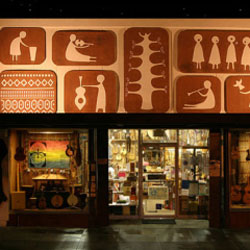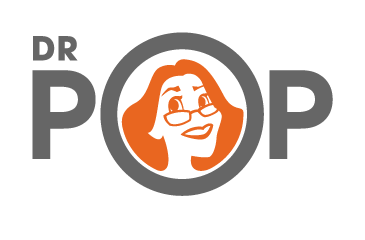
This weekend was more infused with art and music than any other this year, and I’m hoping that this is the sign of a wonderful new trend.
Friday night: Heard the Chuck Boogie Trio at the Soul Sessions, Grand Star Jazz Club in Chinatown. Very, very nice.
 Saturday afternoon: Wandered into the Folk Music Center in Claremont (photo right) after a friend’s graduation ceremony, a fabulous place, that lets you try out all their musical wares. And people do. The place is a friendly happy cacophony. It has history too — the store now has official status as a museum. It was started by Ben Harper‘s grandparents in 1958. Harper grew up in the place and you can easily see how it must have contributed to developing the soul of a musician.
Saturday afternoon: Wandered into the Folk Music Center in Claremont (photo right) after a friend’s graduation ceremony, a fabulous place, that lets you try out all their musical wares. And people do. The place is a friendly happy cacophony. It has history too — the store now has official status as a museum. It was started by Ben Harper‘s grandparents in 1958. Harper grew up in the place and you can easily see how it must have contributed to developing the soul of a musician.
As for me, as soon as we walked in the door, I immediately spied the loveliest little guitar in the world. It had a great sound, too. Our eyes met, we fell in love, and then in 5 minutes, she was mine. The surest and best transaction of my life. That’s my little guitar on the left.
Saturday night: Went to visit Daniel Gonzalez’ print studio in the old Women’s Building on Spring Street. Got to see his exquisite print work and space as well as that of his studio mate, Jaime Zacarias, — a very talented and very original painter.
Outside the studio, right alongside the Spring Street bridge was a tight circle of musicians playing
And up the street was the square dance part of the Old Time is a Good Time Festival hosted by Farmlab, complete with square dance instructions and practice, a great caller, and Sausage Grinder, a wonderful old-time-music band that, of course, turned up at the next day’s festival.
And I had a go at square dancing, moving around with people who I didn’t know, screaming and waving along with them when the Gold Line train whizzed by. This apparently is proper FarmLab screaming and waving behavior around trains.
Sunday: I went to the ever-amazing Topanga Canyon Banjo and Fiddle Contest and Folk Festival — the 50th! — which reinforced my notion that certain music traditions are as much about democracy as the music and have a lot to teach us about both.
The Topanga festival is organized along the same traditions as the finest of folk festivals. There are formal performances on various stages and places and then that player who just took your breadth away might jam with you if you have the chops and a mind to do it. Jamming has its method, like other music where leaders and followers are interchangeable. Players taking turns, often in a circle, under the subtle direction of a leader. There even a Bluegrass Jam School workshop to teach people how to do exactly that. There were workshops for learning and sharing riffs. There were people aged 20 and under with amazing musical chops playing with people 60 and over, often even more amazing, who encouraged and rightfully admired the next generation of fiddlers and pickers.
The festival is fine entertainment indeed, but its tradition of doing, coaching, sharing and mixing it up is to me a much finer space for learning for democracy than all the talking head panels, plenaries, and such that I have frequented too often in my life.
I like the definition of Bluegrass jamming from that I read on the Bluegrass Jam School flier — it is a very Do-It-Together learning model. It is more than a metaphor for democracy. It is what democracy is all about.
The idea behind a bluegrass jam is for musicians who play a common repertoire to gather to make communal music. The quickest way to improve as a Bluegrass musician is to jam with other musicians. As soon as you can play a few simple chords and complete a song without looking at your instrument, from beginning to end with stopping or breaking tempo and without looking ant the music, you are ready to start jamming….To be successful at Bluegrass you should jam with others as often as you can and learn the repertoire.
Now its Sunday night and there is still more music to be had. When I got back from Paramount Ranch (the festival was at this old outdoor movie set in the Santa Monica Mountains — which was more magical than hokie. It was lovely to see people hanging out on the wooden porches of the old-time “storefronts,” playing music in ever-changing groupings).
Gary took me to Disney Hall to hear the phenomenal jazz master, Sonny Rollins. And he was all that. At 80, he walked with the kind of old man shuffle that Red Foxx affected in Sanford and Son, but he played like the ageless jazz god that he is. Here’s a link to Gary’s post Saxophone Colossus about the concert on FourStory. If you’re not familiar with Rollins sound, have a listen here:
Sonny Rollins is part of the jazz tradition that the late great Malachai Thompson wrote about in his article called The Evolution of Jazz and the Survival of Our Democratic Society.
Thompson wanted people to understand the “parallels between the principles that govern jazz and our constitutionally guaranteed freedoms and liberties inherent in our democratic society.” He lists three and discusses them in the article:
1. Jazz requires performers to be informed (you can’t jam if you don’t know the music and the changes)
2. Jazz sounds best when there is group cohesiveness (the jazz group is only as good as its weakest member)
3. Most jazz groups require that each member contribute as a soloist. (everyone has a chance to lead and to follow)
Thompson reminds us that he is talking about when jazz is at its best. It is bluegrass at its best. It is son jarocho at its best. These are the musics of democracy — the kind of music and democracy that most of us crave when it is there to be experienced.
